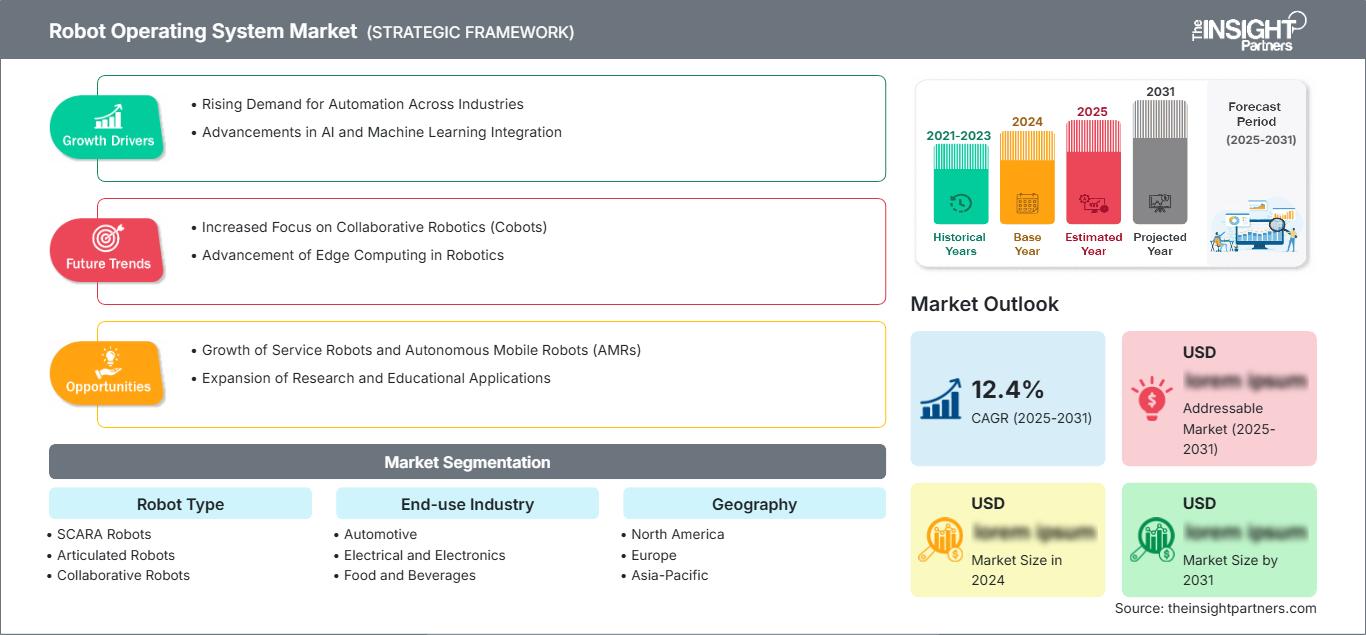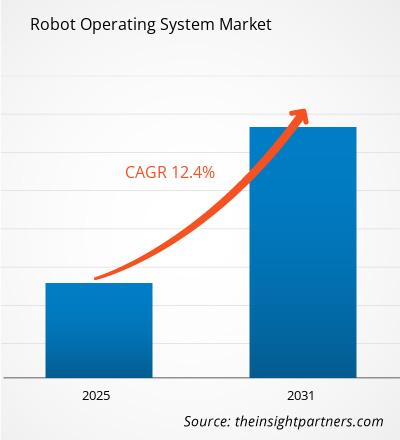ロボットオペレーティングシステム市場は、2025年から2031年にかけて12.4%のCAGRで成長し、市場規模は2024年のXX百万米ドルから2031年にはXX百万米ドルに拡大すると予想されています。
レポートは、ロボットの種類(スカラロボット、多関節ロボット、協働ロボット、直交ロボット、並列ロボット、その他)、最終用途産業(自動車、電気・電子、食品・飲料、ヘルスケア、金属・機械、その他)別にセグメント化されています。世界的な分析は、地域レベルと主要国でさらに細分化されています。レポートでは、上記の分析とセグメントについて米ドルでの価値を提供しています。
レポートの目的
The Insight Partnersによるロボットオペレーティングシステム市場レポートは、現在の状況と将来の成長、主な推進要因、課題、および機会を説明することを目的としています。これにより、次のようなさまざまなビジネス関係者に洞察が提供されます。
- テクノロジープロバイダー/メーカー: 進化する市場のダイナミクスを理解し、潜在的な成長機会を把握して、情報に基づいた戦略的決定を下せるようにします。
- 投資家: 市場の成長率、市場の財務予測、バリューチェーン全体に存在する機会に関する包括的なトレンド分析を実施します。
- 規制機関: 乱用を最小限に抑え、投資家の信頼と信用を維持し、市場の完全性と安定性を維持することを目的として、市場におけるポリシーと警察活動を規制します。
ロボットオペレーティングシステム市場セグメンテーション ロボットタイプ
- スカラロボット
- 多関節ロボット
- 協働ロボット
- 直交ロボット
- パラレルロボット
- その他
最終用途産業
- 自動車
- 電気・電子
- 食品・飲料
- ヘルスケア
- 金属・機械
- その他
レポートの一部、国レベルの分析、Excelデータパックなどを含め、スタートアップ&大学向けに特別オファーや割引もご利用いただけます(無償)
ロボットオペレーティングシステム市場: 戦略的洞察

-
このレポートの主要な市場動向を入手してください。この無料サンプルには、市場動向から見積もりや予測に至るまでのデータ分析が含まれます。
ロボットオペレーティングシステム市場の成長促進要因
- 業界全体で高まる自動化の需要:製造、物流、医療、農業など、さまざまな業界で自動化の導入が進んでいることが、ロボットオペレーティングシステム(ROS)市場の成長を牽引しています。ROSは、開発者がロボットシステムを効率的に構築・制御できる柔軟でモジュール式のフレームワークを提供するため、産業用ロボット、自律走行車、サービスロボットに最適です。業界が自動化を通じて生産性の向上、コストの削減、精度の向上を模索する中、これらのロボットシステムをサポートするROSプラットフォームの需要が急速に高まっています。
- AIと機械学習の統合における進歩:人工知能(AI)と機械学習(ML)技術とロボット工学の統合は、ROS市場のもう1つの重要な推進要因です。ROSはAIおよびMLアルゴリズムとの互換性が高く、ロボットが複雑なタスクを実行し、変化する環境に適応し、リアルタイムで意思決定を行うことを可能にします。 ROS を介して高度な認識、ナビゲーション、意思決定機能を統合できることから、特に自律走行車、ドローン、インテリジェント製造システムなどの分野での ROS の導入が加速しています。
ロボット オペレーティング システム市場の将来の動向
- 協働ロボット (コボット) への注目度の高まり: ROS 市場の顕著なトレンドは、共有ワークスペースで人間のオペレーターと一緒に作業するように設計された協働ロボット (コボット) の台頭です。これらのロボットは、調整、リアルタイムの意思決定、安全監視を ROS に大きく依存しています。製造、物流、医療など、生産性と安全性を高めるためにコボットを導入する業界が増えるにつれて、複雑な人間とロボットのやり取りを処理できる ROS 駆動型プラットフォームの需要が高まっています。 ROSのモジュール式アーキテクチャは、協働ロボットアプリケーションに必要な適応性と柔軟性を備えたシステムの開発に最適です。
- ロボティクスにおけるエッジコンピューティングの進歩:エッジコンピューティングとロボティクスの統合は、ROS市場における新たなトレンドです。エッジコンピューティングにより、ロボットはデータを中央サーバーに送信するのではなく、デバイス上でローカルに処理できるため、レイテンシが短縮され、リアルタイムの意思決定能力が向上します。ROSがエッジコンピューティングフレームワークをサポートすることで、ロボットはクラウドインフラストラクチャに大きく依存することなく、リアルタイムナビゲーションや自律的な意思決定などのより複雑なタスクを処理できます。このトレンドは、自律走行車、ドローン、産業用ロボットなど、低レイテンシとリアルタイム応答が不可欠なアプリケーションにおいて特に重要です。
ロボットオペレーティングシステムの市場機会
- サービスロボットと自律移動ロボット(AMR)の成長:医療、ホスピタリティ、小売などの分野におけるサービスロボットの利用増加は、ROS市場にとって大きなチャンスをもたらします。配達ロボット、清掃ロボット、ヘルスケアアシスタントなどのサービスロボットは、ナビゲーション、物体認識、タスク管理にROSを大きく活用しています。倉庫、配送センター、ラストマイル配送サービスにおける自律移動ロボット(AMR)の需要増加も、大きな成長機会を生み出しています。ROSは、これらのロボットのシームレスな統合とパフォーマンス向上に必要なツールを提供できるため、サービスロボットと物流自動化に大きな市場ポテンシャルが生まれます。
- 研究・教育用途の拡大:ROS市場のもう1つの機会は、学術機関や研究機関におけるROSの利用拡大にあります。ROSはオープンソースで高度にカスタマイズ可能であるため、ロボット工学、AI、自動化を教育する教育現場でますます利用されています。多くの大学や研究機関がROSを使用して実験的なロボットシステムを開発し、ロボット工学、AI、IoTなどのさまざまな分野で実験を行っています。ロボット工学と STEM (科学、技術、工学、数学) 教育に重点を置いた教育プログラムの成長により、ROS プラットフォームの採用が促進され、ROS 上に構築された教育ツールとリソースの新しい市場が生まれています。
ロボットオペレーティングシステム市場の地域別分析
予測期間を通じてロボットオペレーティングシステム市場に影響を与える地域的な傾向と要因については、The Insight Partnersのアナリストが詳細に解説しています。このセクションでは、北米、ヨーロッパ、アジア太平洋、中東・アフリカ、中南米におけるロボットオペレーティングシステム市場のセグメントと地域についても解説しています。
ロボットオペレーティングシステム市場レポートの範囲
| レポート属性 | 詳細 |
|---|---|
| の市場規模 2024 | US$ XX million |
| 市場規模別 2031 | US$ XX Million |
| 世界的なCAGR (2025 - 2031) | 12.4% |
| 過去データ | 2021-2023 |
| 予測期間 | 2025-2031 |
| 対象セグメント |
By ロボットの種類
|
| 対象地域と国 |
北米
|
| 市場リーダーと主要企業の概要 |
|
ロボットオペレーティングシステム市場のプレーヤー密度:ビジネスダイナミクスへの影響を理解する
ロボットオペレーティングシステム市場は、消費者の嗜好の変化、技術の進歩、製品の利点に対する認知度の高まりといった要因によるエンドユーザーの需要増加に牽引され、急速に成長しています。需要の増加に伴い、企業は製品ラインナップの拡充、消費者ニーズへの対応のためのイノベーション、そして新たなトレンドの活用を進めており、これが市場の成長をさらに加速させています。

- 入手 ロボットオペレーティングシステム市場 主要プレーヤーの概要
主なセールスポイント
- 包括的な調査範囲:本レポートは、ロボットオペレーティングシステム市場の製品、サービス、種類、エンドユーザーの分析を包括的に網羅し、包括的な展望を提供しています。
- 専門家による分析:本レポートは、業界の専門家とアナリストの深い理解に基づいて作成されています。
- 最新情報:本レポートは、最新の情報とデータトレンドを網羅しているため、ビジネスの関連性を保証します。
- カスタマイズオプション:本レポートは、特定のクライアントの要件に対応し、ビジネス戦略に適切に適合するようにカスタマイズできます。
したがって、ロボットオペレーティングシステム市場に関する調査レポートは、業界のシナリオと成長の見通しを解読し理解するための先導役となります。いくつかの正当な懸念事項があるかもしれませんが、本レポートの全体的なメリットは、デメリットを上回る傾向があります。
- 過去2年間の分析、基準年、CAGRによる予測(7年間)
- PEST分析とSWOT分析
- 市場規模価値/数量 - 世界、地域、国
- 業界と競争環境
- Excel データセット
最新レポート
関連レポート
お客様の声
購入理由
- 情報に基づいた意思決定
- 市場動向の理解
- 競合分析
- 顧客インサイト
- 市場予測
- リスク軽減
- 戦略計画
- 投資の正当性
- 新興市場の特定
- マーケティング戦略の強化
- 業務効率の向上
- 規制動向への対応






















 無料サンプルを入手 - ロボットオペレーティングシステム市場
無料サンプルを入手 - ロボットオペレーティングシステム市場